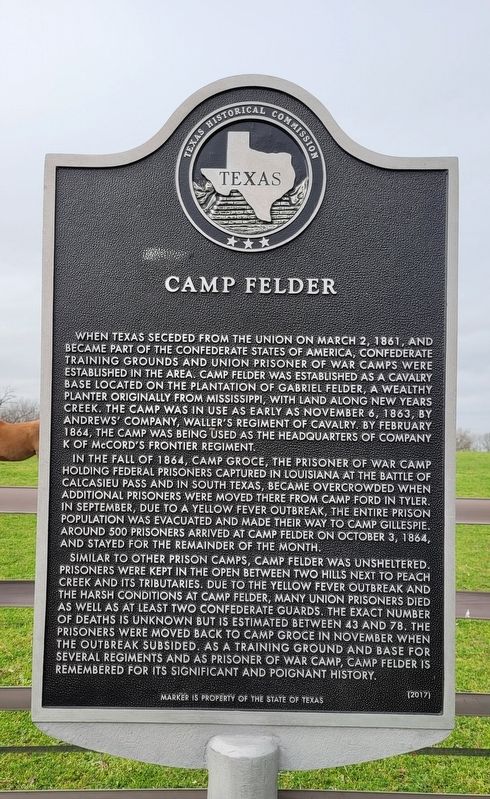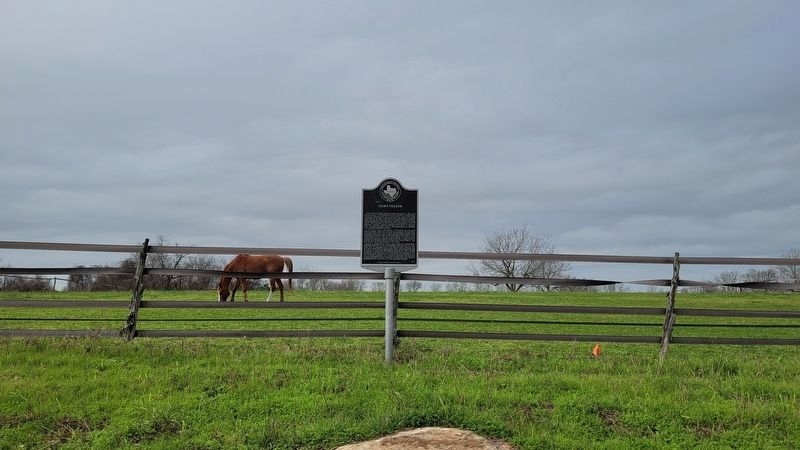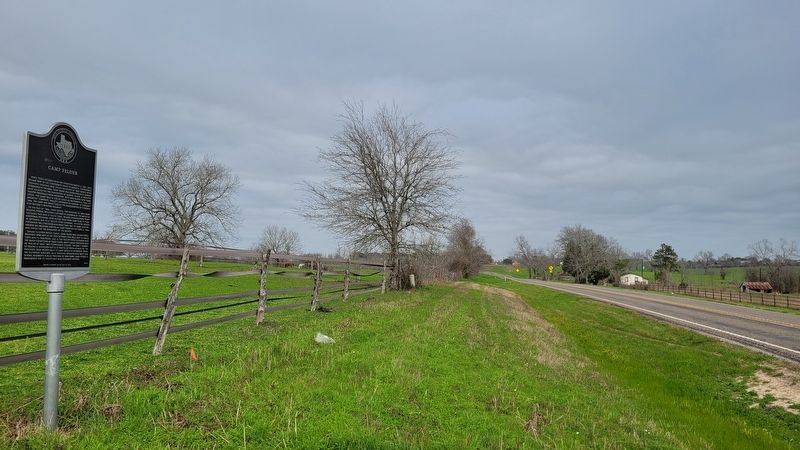Whitman in Washington County, Texas — The American South (West South Central)
Camp Felder
In the fall of 1864, Camp Groce, the prisoner of war camp holding Federal prisoners captured in Louisiana at the Battle of Calcasieu Pass and in South Texas, became overcrowded when additional prisoners were moved there from Camp Ford in Tyler. In September, due to a yellow fever outbreak, the entire prison population was evacuated and made their way to Camp Gillespie. Around 500 prisoners arrived at Camp Felder on October 3, 1864, and stayed for the remainder of the month.
Similar to other prison camps, Camp Felder was unsheltered. Prisoners were kept in the open between two hills next to Peach Creek and its tributaries. Due to the yellow fever outbreak and the harsh conditions at Camp Felder, many Union prisoners died as well as at least two Confederate guards. The exact number of deaths is unknown but is estimated between 43 and 78. The prisoners were moved back to Camp Groce in November when the outbreak subsided. As a training ground and base for several regiments and as prisoner of war camp, Camp Felder is remembered for its significant and poignant history.
Erected 2017 by Texas Historical Commission. (Marker Number 18640.)
Topics. This historical marker is listed in this topic list: War, US Civil. A significant historical date for this entry is October 3, 1863.
Location. 30° 13.967′ N, 96° 14.335′ W. Marker is in Whitman, Texas, in Washington County. Marker is on Farm to Market Road 1155, 0.6 miles south of Farm to Market Road 2193, on the left when traveling north. The marker is located along the west side of the highway. Touch for map. Marker is at or near this postal address: 1502 FM 1155, Washington TX 77880, United States of America. Touch for directions.
Other nearby markers. At least 8 other markers are within 7 miles of this marker, measured as the crow flies. Barrington Plantation (approx. 3˝ miles away); Cedar Creek Community (approx. 5.6 miles away); Chappell Hill Masonic Cemetery (approx. 5.6 miles away); Friedens Church of Washington, UCC (approx. 5.8 miles away); Brown's Prairie School and Building (approx. 5.8 miles away); Farmers State Bank and Reinstein Store (approx. 6.3 miles away); Old Rock Store (approx. 6.4 miles away); Methodist Church (approx. 6.4 miles away).
Also see . . .
1. Felder, Gabriel (1797–1868). Texas State Historical Association
Gabriel Felder, judge, was born in Orangeburg, South Carolina, on January 29, 1797, the son of Samuel and Ann (Horger) Felder. He was a justice of the peace in his young manhood and thereafter was known as Judge. He moved first to Mississippi, where he married. In the spring of 1851 he moved to Texas with his wife, Ann, and two sons. He settled in Washington County and between 1852 and 1856 purchased several tracts of land totaling 2,418 acres on the banks of New Year Creek, at a cost of more than $19,000, to be paid as he received money from his property in South Carolina. He had inherited a fourth of the estate of his brother, John M. Felder, of Orangeburg, South Carolina, amounting to $100,000, which included $48,830 in "Negro property," or ninety-five slaves, and $51,000 in money, mules, and horses. Jesse Y. Felder, a relative, was employed to bring the slaves from South Carolina to Texas. They arrived about June 20, 1854, too late to make a crop that year.(Submitted on February 27, 2023, by James Hulse of Medina, Texas.)
2. American Civil War prison camps. Wikipedia
Between 1861 and 1865, American Civil War prison camps were operated by the Union and the Confederacy to detain over 400,000 captured soldiers. From the start of the Civil War through to 1863 a parole exchange system saw most prisoners of war swapped relatively quickly. However, from 1863 this broke down following the Confederacy's refusal to treat black and white Union prisoners equally, leading to soaring numbers held on both sides.(Submitted on February 27, 2023, by James Hulse of Medina, Texas.)
Credits. This page was last revised on February 27, 2023. It was originally submitted on February 27, 2023, by James Hulse of Medina, Texas. This page has been viewed 448 times since then and 160 times this year. Photos: 1, 2, 3. submitted on February 27, 2023, by James Hulse of Medina, Texas.


